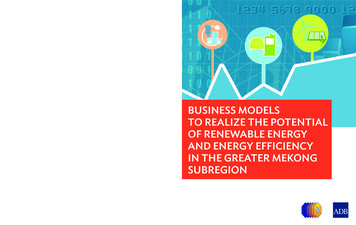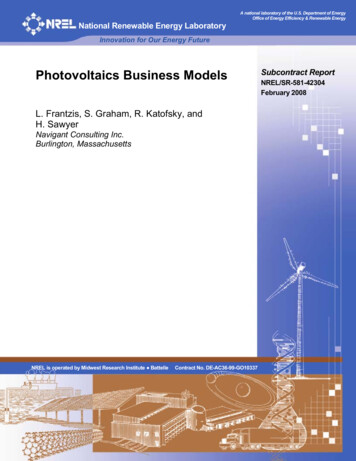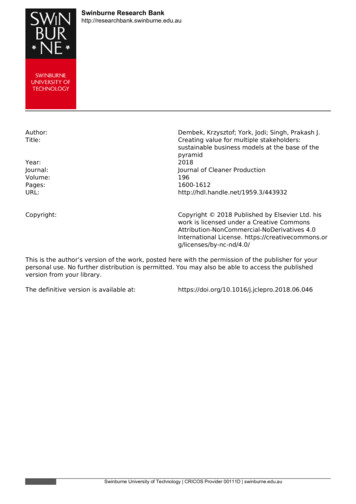
Transcription
Business Models to Realize the Potential of Renewable Energy and Energy Efficiencyin the Greater Mekong SubregionAbout the Asian Development BankADB’s vision is an Asia and Pacific region free of poverty. Its mission is to help its developing membercountries reduce poverty and improve the quality of life of their people. Despite the region’s many successes,it remains home to the majority of the world’s poor. ADB is committed to reducing poverty through inclusiveeconomic growth, environmentally sustainable growth, and regional integration.Based in Manila, ADB is owned by 67 members, including 48 from the region. Its main instruments forhelping its developing member countries are policy dialogue, loans, equity investments, guarantees, grants,and technical assistance.ASIAN DEVELOPMENT BANK6 ADB Avenue, Mandaluyong City1550 Metro Manila, Philippineswww.adb.orgBUSINESS MODELS TO REALIZE THE POTENTIAL OF RENEWABLE ENERGY AND ENERGY EFFICIENCYIN THE GREATER MEKONG SUBREGIONThis report was produced under the technical assistance project Promoting Renewable Energy, Clean Fuels,and Energy Efficiency in the Greater Mekong Subregion (TA 7679). It provides outlines of business modelsrelevant to pursuing the renewable energy and energy efficiency targets adopted by the five Greater MekongSubregion countries: Cambodia, the Lao People’s Democratic Republic, Myanmar, Thailand, and Viet Nam.Business models for investments in renewable energy and energy efficiency provide policy makers andinvestors with alternative business methods for the deployment of new technologies, or for the application ofwell-established technologies and practices in new settings.BUSINESS MODELSTO REALIZE THE POTENTIALOF RENEWABLE ENERGYAND ENERGY EFFICIENCYIN THE GREATER MEKONGSUBREGIONASIAN DEVELOPMENT BANK
BUSINESS MODELSTO REALIZE THE POTENTIALOF RENEWABLE ENERGYAND ENERGY EFFICIENCYIN THE GREATER MEKONGSUBREGION
2015 Asian Development BankAll rights reserved. Published in 2015.Printed in the Philippines.ISBN 978-92-9254-827-8 (Print), 978-92-9254-828-5 (e-ISBN)Publication Stock No. RPT146842-2Cataloguing-in-Publication DataAsian Development Bank.Business models to realize the potential of renewable energy and energy efficiency in the Greater Mekong Subregion.Mandaluyong City, Philippines: Asian Development Bank, 2015.1. Renewable energy.2. Energy efficiency.I. Asian Development Bank.3. Business models.4. Greater Mekong Subregion.The views expressed in this publication are those of the authors and do not necessarily reflect the views and policies of theAsian Development Bank (ADB) or its Board of Governors or the governments they represent.ADB does not guarantee the accuracy of the data included in this publication and accepts no responsibility for anyconsequence of their use.By making any designation of or reference to a particular territory or geographic area, or by using the term “country” in thisdocument, ADB does not intend to make any judgments as to the legal or other status of any territory or area.ADB encourages printing or copying information exclusively for personal and noncommercial use with properacknowledgment of ADB. Users are restricted from reselling, redistributing, or creating derivative works for commercialpurposes without the express, written consent of ADB.Note: In this report, “ ” refers to US dollars.Asian Development Bank6 ADB Avenue, Mandaluyong City1550 Metro Manila, PhilippinesTel 63 2 632 4444Fax 63 2 636 2444www.adb.orgFor orders, please contact:Public Information CenterFax 63 2 636 2584adbpub@adb.org
ContentsTables and Figures ivForeword vAcknowledgments viiAbbreviations viii123Introduction 14Service Business Models 12User Cooperative 12Energy Performance Contracting 165Business Model Examples 19Decentralized Systems 21Centralized Grid-Scale Systems 31Energy Efficiency 32Basic Purpose and Broad Categories of Business Models 3Ownership Business Models 5Public–Private Partnership 5Multiparty Ownership 7Lease or Hire Purchase Model 8Dealer Credit Business Model 106 Conclusions 35References 38iii
Tables and FiguresTables3.1 PPP–BOOT Model for a Power Plant Project: Key Aspects 73.2 Multiparty Ownership Model for an Energy Project: Key Aspects 73.3 Dealer Credit Model: Key Aspects 104.1 User Cooperative: Main Features 144.2 User Cooperative Business Model: Risks and Mitigation Measures 154.3 Energy Performance Contracting Business Model: Risks and Mitigation Measures 185.1 Solar Battery Charging Stations: Potential Issues and Mitigation Measures 235.2 Hybrid Minigrid Systems: Issues and Mitigation Measures 28Figures3.1 PPP–BOOT Model for a Power Plant Projects: Relationship Diagram 3.2 Multiparty Ownership Model for a Combined Biomass Digester and BiogasPower Generation System: Relationship Diagram 3.3 Community Digester System: Relationship Diagram 3.4 Lease or Hire Purchase Model Based on Independent Leasing:Relationship Diagram 3.5 Dealer Credit Model: Relationship Diagram 4.1 User Cooperative Business Model 4.2 Energy Performance Contract: Guaranteed–Savings Relationship Diagram 4.3 Energy Performance Contract: Pay-as-You-Save Relationship Diagram 5.1 Project Stakeholder Options 5.2 Solar Battery Charging Stations: Stakeholder Structure 5.3 Hybrid Minigrid Systems: Stakeholder Structure 5.4 Community Biogas Projects: Stakeholder Structure 5.5 Large-Scale Grid-Connected Project Systems: Stakeholder Structure 5.6 Energy Performance Contracting Model iv689911131717202226293233
ForewordIn 2010, the Asian Development Bank (ADB) initiated the regional technical assistanceproject Promoting Renewable Energy, Clean Fuels, and Energy Efficiency in the GreaterMekong Subregion (GMS), to assist the countries in the GMS—Cambodia, the LaoPeople’s Democratic Republic (Lao PDR), Myanmar, Thailand, and Viet Nam (the GMScountries)—in improving their energy supply and security in an environmentally friendlyand collaborative manner. The Yunnan Province and Guangxi Zhuang Autonomous Regionof the People’s Republic of China, which are also part of GMS, are not included in this studydue to difficulties of segregation of national level data. The project was cofinanced by theAsian Clean Energy Fund and the Multi-Donor Clean Energy Fund under the Clean EnergyFinancing Partnership Facility of ADB.The study prepared three reports: (i) Renewable Energy Developments and Potential inthe Greater Mekong Subregion, (ii) Energy Efficiency Developments and Potential EnergySavings in the Greater Mekong Subregion, and (iii) Business Models to Realize the Potentialof Renewable Energy and Energy Efficiency in the Greater Mekong Subregion.The first report provides estimates of the theoretical and technical potential of selectedrenewable energy sources (solar, wind, bioenergy) in each of the countries, together withoutlines of the policy and regulatory measures that have been introduced by the respectivegovernments to develop this potential. The second report addresses the potentialsavings for each of the countries from improved energy efficiency and conservationmeasures. The third report outlines business models that the countries could use to realizetheir renewable energy and energy efficiency potential, including the deployment of newtechnologies.The renewable energy report concludes that, apart from Thailand, the GMS countries areat an early stage in developing their renewable energy resources. To further encouragerenewable energy development, the GMS countries should provide support for public andprivate projects investing in renewable energy. Solar energy is one which is being activelypromoted in the region. While the cost of solar power is still high relative to conventionalsources, it is a cost competitive alternative in areas that lack access to grid systems. Largescale solar systems are being developed in Thailand whilst home- and community-basedsolar systems are increasingly becoming widespread in the GMS. Large-scale developmentof wind power depends on suitable wind conditions and an extensive and reliable gridsystem as backup; Viet Nam has the required combination and is gradually developingthe potential. Biofuel production raises questions concerning the agriculture–energynexus, but Cambodia, the Lao PDR, and other GMS countries are striving to reduce theirdependence on imported oil and gas by promoting suitable biofuel crops. Biogas productionfrom animal manure has been hampered by the difficulty of feedstock collection and thefrequent failure of biodigesters. The gradual move to larger-scale farming techniques andnew biodigester technologies has led to expanded biogas programs—especially for off-gridv
Forewordfarm communities. The GMS countries have learned that maintenance and technologysupport is of vital importance in sustaining investments in renewable energy.The energy efficiency report presents the steps each of the five countries has taken in thisregard, noting that much greater gains in energy savings are possible while their efficiencymeasures are progressive. Most of the GMS countries envisage energy efficiency savingsof at least 10% over the next 15–20 years except Thailand which is targeting 20%. Thailandand, to a lesser extent, Viet Nam have advanced policy, institutional, and regulatoryframeworks for pursuing their energy efficiency savings targets, while Cambodia, the LaoPDR, and Myanmar are less well structured to reach their goals.The renewable energy and energy efficiency reports chart a way for the GMS countriesto become less dependent on imported fuels and more advanced in developing “green”economies. Global climate change concerns dictate greater attention to renewable energyand energy efficiency. National interests are served by both, offering a win–win outcomefrom investment in renewable energy and energy efficiency measures. The report onbusiness models indicates ways in which these investments can be made through public–private partnerships, providing a basis for further dialogue among stakeholders.In collaboration with the governments of Cambodia, the Lao PDR, Myanmar, Thailand, andViet Nam, ADB has published these reports with the objective of helping to accelerate thedevelopment of renewable energy and energy efficiency in the Greater Mekong Subregion.James A. NugentDirector GeneralSoutheast Asia Departmentvi
AcknowledgmentsThe Asian Development Bank (ADB) carried out the regional technical assistanceproject in collaboration with the following government agencies: the Ministry ofMines and Energy, Cambodia; the Ministry of Energy and Mines, the Lao People’sDemocratic Republic; the Ministry of Energy, Myanmar; the Department of AlternativeEnergy Development and Efficiency, Ministry of Energy, Thailand; and the ElectricityRegulatory Authority of Viet Nam.In ADB, Jong-Inn Kim, lead energy specialist, Energy Division, Southeast Asia Department(SERD), initiated the report and gave technical advice. The peer reviewer of this reportwas Neeraj Jain, senior advisor, Office of the Director General, SERD and Hyunjung Lee,energy economist, Energy Division, SERD. Ma. Trinidad Nieto, associate project analyst,Energy Division, SERD, provided administrative support during the implementation of thetechnical assistance project. David Husband served as economics editor and Maria CristinaPascual as publishing coordinator. James Nugent, director general, SERD, and Chong ChiNai, director, Energy Division, SERD, provided guidance in the preparation of this report.Lahmeyer International GmbH, headquartered in Germany, was contracted by the AsianDevelopment Bank to assess the low-carbon renewable and energy efficiency potentialin five of the Greater Mekong Subregion countries (Cambodia, the Lao PDR, Myanmar,Thailand and Viet Nam). Further, Lahmeyer International lead a series of workshops inthe five countries, to share experiences and to advance technical knowledge on theopportunities and challenges. The assessment of renewable and energy efficiencypotential in the subregion was based on earlier reports, secondary research, and availabledata. The assessment included review of business models to operationalize the identifiedopportunities. Because of changing weather patterns and data uncertainties, Lahmeyerrecommends that the research and findings - particularly those pertaining to renewableenergy - be used as indicative guidelines rather than as a basis for specific investments.vii
AbbreviationsADBBOOTESCOGMSkWLao �–Asian Development Bankbuild–own–operate–transferenergy service companyGreater Mekong SubregionkilowattLao People’s Democratic Republicmicrofinance institutionmegawattnongovernment organizationoperation and maintenancepurchase power agreementpublic–private partnershipPeople’s Republic of Chinasolar battery charging stationsmall and medium-sized enterprisesspecial-purpose companyspecial-purpose vehicletechnical assistanceUnited Nations Development Programme
1T Introductionhis publication on business models for renewable energy and energy efficiency isdesigned to complement two companion publications of the Asian DevelopmentBank (ADB):Renewable Energy Developments and Potential in the Greater Mekong Subregion;andEnergy Efficiency Developments and Potential Energy Savings in the GreaterMekong Subregion.These two publications focus on the potential for renewable energy and energy efficiencyin Cambodia, the Lao People’s Democratic Republic (Lao PDR), Myanmar, Thailandand Viet Nam, highlighting what has been accomplished so far and their “green energy”possibilities over the next 15–20 years. This third publication provides outlines of businessmodels relevant to pursuing the ambitious renewable energy and energy efficiency targetsadopted by the five countries—collectively referred to here as the Greater MekongSubregion (GMS).1Investments in renewable energy and energy efficiency generate benefits to societyas a whole that cannot be fully reflected in investment returns, leading thereby tounderinvestment by the private sector. Consequently, there is a strong case for publicsector support for renewable energy and energy efficiency initiatives. Most importantly,these initiatives contribute to reducing the emission of greenhouse gases and theclimate change consequences that threaten global livelihoods. More immediately, theylessen the vulnerability of energy dependence and the financial burden of oil imports.Further, advances in energy efficiency reduce energy costs and contribute to improvedcompetitiveness. Energy savings also contribute to supplying more consumers and slowingthe growth in demand for electricity, an important consideration in Southeast Asia wherelarge areas continue to depend on firewood and other biomass sources of energy.Business models for investments in renewable energy and energy efficiency providepolicy makers and investors with alternative business methods for the deployment of newtechnologies, or for the application of well-established technologies and practices in new1The Greater Mekong Subregion includes Yunnan Province and Guangxi Zhuang Autonomous Region ofthe People’s Republic of China.1
Business Models to Realize the Potential of Renewable Energy and Energy Efficiency in the Greater Mekong Subregionsettings. Generally, these models are designed to address various impediments to makingsuch investments, including the following (ECN 2012): information shortcomings, leading to a lack of awareness and knowledge of theimportance of renewable energy and energy efficiency;regulatory barriers, leading to cumbersome procurement rules and permitprocesses; andfinancial barriers, reflecting poorly developed banking services, high up-front costsof investment, and low initial returns.The business models outlined here focus first on ways of spreading risk and overcomingfinancial barriers to investing in renewable energy and energy efficiency projects, andsecondly on the provision of services to facilitate such investment. The key features of themodels are described, together with their advantages and disadvantages. A few examplesof how these models have been applied in practice are drawn from GMS countries. Theintent of the ADB technical assistance (TA) was for each of the five countries to providethree examples of renewable energy and energy efficiency business models that wereeither effective or not, the latter to help other countries steer clear of models that haveproven difficult. Unfortunately, this aspect of the TA was largely unfulfilled. Internationalbest practices may be drawn from various reports of the World Energy Council, theInternational Energy Agency, and other lead organizations.2
2Basic Purposeand Broad Categoriesof Business ModelsBusiness models structure how business investments are to be designed,implemented, and managed, and incorporate critical financing, service, andmonitoring features. The most appropriate business model for a given project willdepend on local conditions, the financial and regulatory environment, and the institutionalframework and support mechanisms in place. The scale and purpose of the project orservice must be well defined, together with the end consumers. Business models are notset structures; each must be adapted to the local circumstances and risk profiles of theselected project.Business models can be broadly categorized as follows: ownership models, which focus on financing and risk mitigation concerns; andservice models, which focus on providing specified services and highlight differentmethods of operation and maintenance.In practice, most real-world business models are hybrids, combining elements of varioustypes and approaches. For example, a utility or a private company may develop and owna minigrid system, operated and managed in turn by a community-based organization,while a private maintenance company provides the technical backup and support services(Rolland 2011).The following considerations bear on the choice of the appropriate business model:(i) product or service considerations, (ii) the scale of the project, (iii) the consumer, and(iv) the regulatory environment.Product or Service ConsiderationsAs a rule, projects are assessed mainly in terms of their financial feasibility. However,renewable energy and energy efficiency projects may also have important, nonquantifiableor nonmonetizable public good benefits. Rural electrification projects, for example, maycontribute to the following benefits: labor savings (from not having to collect wood);reduced deforestation (from less reliance on fuel wood and charcoal);health benefits (from reduced indoor air pollution and improved water andsanitation services);3
Business Models to Realize the Potential of Renewable Energy and Energy Efficiency in the Greater Mekong Subregion education benefits (from improved lighting in schools and residences, and betterstudy conditions); andreduced poverty (from agricultural and industrial productivity improvements).Such benefits would be difficult to reflect in electricity tariffs for consumers. Theappropriate business model may therefore need to provide for some form of publicsubsidy or recognition that tariffs would at most cover only the cost of supply.The Scale of the ProjectThe type of business model chosen depends largely on the scale of the project and itsinvestment costs. The business model required for a residential or community-scale ruralelectrification solar project is very different from that for a 200 megawatt (MW) projectdesigned to supply the national grid.The ConsumerIs the consumer a household, a small village cooperative, a large industrial user, or thenational grid company? The appropriate administration requirements and individualpayment risk will vary markedly depending on the nature of the consumer.The Regulatory Environment“Business models are designed to extract maximum value from a business activityconducted within a particular regulatory framework. It is the regulatory environment,therefore, that is largely instrumental in shaping the various business models that havebeen developed” (APEC Energy Working Group 2009). This is particularly true forbusiness models that are wholly dependent on regulatory or institutional mechanisms,such as feed in tariffs, tax credit systems, or clean-energy quotas.4
3Ownership Business ModelsOwnership business models address the technical complexity, economies of scale,capital costs, and funding challenges of renewable energy and energy efficiencyprojects. For medium- to large-scale or grid-connected projects, the mostappropriate ownership business model is frequently a public–private partnership (PPP),implemented as a form of build–own–operate–transfer (BOOT) or multiparty ownership.Smaller-scale projects frequently involve lease or hire purchase and dealer credit salemodels. Each of these models is described in the following subsections.Public–Private PartnershipPPP schemes usually provide a service or exclusivity in the right to “own” specified publicinfrastructure, such as a highway section, over a given period of time, and the right toimpose a toll for its use. A PPP involves a contract between a public sector authority anda private party, in which the private party provides a public service (e.g., electricity supply)and assumes a substantial amount of the financial, technical, and operating requirements.The main purpose of a PPP is to allocate the tasks and risks to those parties best able tomanage them, notably to the private sector partners.Depending on how the PPP contract is structured, the cost of using the service can beborne exclusively by the users of the service (no taxpayer or public participation) orthe government, or by both in some blend of these opposite approaches. Governmentcontributions to a PPP may also be in kind, for example, the transfer of assets or land.Alternatively, the government may support the project by providing revenue subsidies,through favorable taxes or other means.Common PPP models are: build–own–operate–transfer (BOOT) model;build–own–operate (BOO) model; andbuild–own–transfer (BOT) model.PPP schemes typically involve the creation of a special-purpose company (SPC) or specialpurpose vehicle (SPV) to develop, build, maintain, and operate the (project) asset for acontracted period of time. The SPC or SPV enters into a contract with the governmentand with subcontractors to build the facility and then operates and maintains it. Because5
Business Models to Realize the Potential of Renewable Energy and Energy Efficiency in the Greater Mekong Subregionof their complexity and high overhead costs, BO(O)T forms of PPP are usually favored forlarge infrastructure projects.The special-purpose or project company is the central administrative and operating entityhandling all contracts for funding with equity and debt investors. It also manages theconstruction and operation and maintenance (O&M) contracts, as well as the billing ofend users. This type of business model is suitable for both conventional and renewableenergy projects. An example of a possible PPP–BOOT business model for a power plantproject is shown in Figure 3.1. Table 3.1 summarizes key aspects of the business model.Figure 3.1:PPP–BOOT Model for a Power Plant Project:Relationship ersSpecial PurposeCompanyenctpaymtraconFSAtEPcraCownntco&MO nteympaEPCContractorBanksdebt uelmaintenanceO&MService ProviderpaymentFuel SupplieraBOOT build–own–operate–transfer model; EPC engineering, procurement, and construction;FSA fuel supply agreement; O&M operation and maintenance; PPA power purchase agreement;PPP public–private partnership.aFor thermal plants only.6
Ownership Business ModelsTable 3.1:PPP–BOOT Model for a Power Plant Project: Key AspectsItemFeatures of the ModelKey AspectsA special-purpose company (SPC) or special-purpose vehicle (SPV) is createdto develop, build, maintain, and operate the plant, and assume a substantialportion of its financial, technical, and operating requirements, thus minimizingrisk to the public entity.A power purchase agreement is established between the SPC or SPV and apublic or private utility.ImplementationSuitable for larger, normally grid-connected, power plantsBenefitsEnables the allocation of specific risks to those parties best able to manage themDisadvantagesCan be extremely complex, involve high transaction costs, and be costly to thepublic if risks are misallocatedBOOT build–own–operate–transfer model, PPP public–private partnership.Multiparty OwnershipA multiparty ownership model is particularly suited to energy projects with high technicalcomplexity or multiple separate elements, such as biogas production and power generation.Multiparty ownership models are frequently combined with user co-op models so thatthe projects are part public and part private. This ownership model can be a good optionfor multipurpose renewable energy projects, such as community-based biogas digesterprojects. Key aspects of the multiparty ownership model, as applied to an energy project,are presented in Table 3.2.Table 3.2:Multiparty Ownership Model for an Energy Project: Key AspectsItemKey AspectsFeatures of the ModelRenewable energy or energy efficiency projects may be technically complex andhave high capital costs, requiring special models (to achieve economy of scale).In the case of biogas digester generation systems, the power-generatingequipment is funded and installed by the utility, and the digester is owned andmaintained by a third party (energy service company, user cooperative, or otherentity).In the biogas digester generation example, funding is provided by a third-partyinstaller or an outside source, freeing the farmer from any major liability. Theequipment is installed at the farmer’s site.Revenues from the sale of the biogas to the utility are used to repay debt andinterest.ImplementationBiogas systems, micro- or minigrid systemsBenefitsLow risk for farmer; can incorporate donor funding for rural electrificationDisadvantagesHigh technical risk (particularly if third-party maintenance company does notproperly support the farmer)7
Business Models to Realize the Potential of Renewable Energy and Energy Efficiency in the Greater Mekong SubregionThe multiparty ownership aspects for a combined biomass digester and biogaspower generation system are illustrated in Figures 3.2 and 3.3. Figure 3.2 illustratesthe relationships among the farmer, the third-party energy supply company, and thepower utility. Figure 3.3 elaborates on the networking required to realize economiesof scale and to make the overall system commercially viable. The power generationplant is placed centrally to facilitate collection of the biogas. The biodigesters maybe owned by the individual farmers, a cooperative of farmers, or a separate company.The energy generation equipment is normally owned and maintained by theofftake utility.Figure 3.2: Multiparty Ownership Model for a Combined Biomass Digesterand Biogas Power Generation System: Relationship DiagramFarmer’s SlurrydeliveryabiogasAnaerobic Digestion(Farmer’s Site)fundingmaintenanceThird PartyPower Generation(Farmer’s Site)energybiogas sale contractbbiogas paymentcO&MUtilityenergysales– farmers have no equipment liability– site-related risk with third party or utilityO&M operation and maintenance.aFarmers obliged to deliver slurry and provide land.bMost likely requiring tripartite agreement.cTo cover debt and interest of digester.Lease or Hire Purchase ModelThis model is another variant of the ownership business model. Typically, it enables usersto purchase equipment in installments. A leasing company (lessor) or equipment supplierprovides the equipment to the end user for a contracted period of time in exchange forregular payments. The lessor is responsible for sourcing, financing, and installing theequipment, and for maintaining it during the contract period. Depending on the provisionsof the contract, at the end of the contract period ownership of the equipment can eitherremain with the lessor or pass to the lessee (sometimes for an additional amount). Leasedequipment cannot become an inherent part of a building, industrial facility, or power8
Ownership Business ModelsFigure 3.3:Community Digester System: Relationship DiagramFarmer 1SlurryFarmer 2SlurryFarmer 3SlurrymultiplelandleaseAnaerobic DigestionCentral SiteFarmer or Communalor OthersCommunity orPrivately Owned Land land leaselesseepaymentfundingland lease agreementbiogasmaintenancebiogas salescontractThird PartyPower Generationon Digester SiteenergyO&MUtilitybiogas paymenta– farmers have no equipment liability– site-related risk with third party or utility– project may benefit from lease payment/property exemption if on commercial landenergysalesO&M operation and maintenance.aTo cover debt and interest of digester.generation plant. Rather, it must be “fungible”—interchangeable, removable, or usableelsewhere. This provision makes the model inapplicable to some renewable energy andenergy efficiency projects. Figure 3.4 illustrates a lease or hire purchase business modelbased on an independent leasing company.Lease or Hire Purchase Model Based on Independent Leasing:Relationship DiagramFigure 3.4:Consumer(Lessee)lease agreementfinancelease paymentdebtrepaymentEquipment(Lessor-owned)Leasing vider9
Business Models to Realize the Potential of Renewable Energy and Energy Efficiency in the Greater Mekong SubregionDealer Credit Business ModelThe dealer credit business model is still another variant of the ownership business model,where the equipment or system supplier provides the initial credit for the system. “As a‘one-stop-shop’, the micro-finance institution (MFI) and
measures. The third report outlines business models that the countries could use to realize their renewable energy and energy efficiency potential, including the deployment of new technologies. The renewable energy report concludes that, apart from Thailand, the GMS countries are at an early stage in developing their renewable energy resources.










